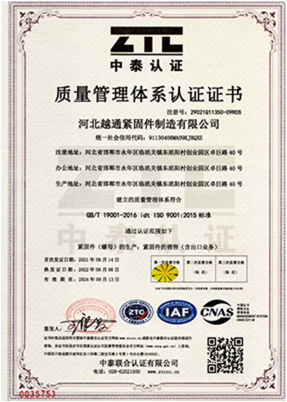Ago . 07, 2024 23:15 Back to list
Exploring the Benefits and Applications of Chemical Anchor Threaded Rods in Construction Projects
Understanding Chemical Anchor Threaded Rods A Comprehensive Overview
In the realm of construction and engineering, the reliability and strength of fastening systems are paramount. Among the various methods and products available, chemical anchor threaded rods have emerged as a preferred choice for securing heavy loads and ensuring structural integrity. This article delves into what chemical anchor threaded rods are, their benefits, applications, and proper installation techniques.
What are Chemical Anchor Threaded Rods?
Chemical anchor threaded rods are a type of fastener used in conjunction with a chemical adhesive or epoxy to create strong and durable connections in various materials, particularly concrete. Unlike conventional mechanical anchors that rely solely on friction, chemical anchors bond not only mechanically but also chemically with the substrate, which significantly enhances their load-bearing capacity and resistance to environmental factors.
Benefits of Chemical Anchor Threaded Rods
1. High Load Capacity One of the primary advantages of using chemical anchor threaded rods is their ability to carry heavy loads. The chemical bonding process allows for load distribution over a larger area, reducing the likelihood of failure under stress.
2. Versatile Applications These threaded rods are suitable for a wide range of applications, from securing steel structures and machinery to affixing wooden beams and brackets. They can be used in both internal and external environments, making them ideal for diverse construction projects.
3. Weather Resistance Chemical anchors are often resistant to moisture, chemicals, and temperature variations. This property minimizes the risk of rust or corrosion, which is especially important in marine environments or in areas with extreme weather conditions.
4. Adjustability Unlike mechanical anchors, chemical anchors allow for some level of adjustability during installation. Once the adhesive is cured, the connection is permanent, but during the setting period, there is a brief window to make minor adjustments to the positioning of the rod.
Installation Process
chemical anchor threaded rod

Proper installation of chemical anchor threaded rods is critical to ensure their effectiveness and longevity. Below is a step-by-step guide to the installation process
1. Drilling the Hole Begin by drilling a hole into the substrate (usually concrete) using a hammer drill. The diameter and depth of the hole must conform to the specifications provided by the manufacturer.
2. Cleaning the Hole After drilling, it is essential to clean the hole thoroughly to remove any dust, debris, or moisture. This can be achieved using compressed air or a vacuum. Proper cleaning enhances the bond strength of the adhesive.
3. Injecting the Adhesive Insert a cartridge of structural adhesive into a caulking gun. Following the manufacturer's instructions, inject the adhesive into the hole until the space is filled, ensuring that it reaches the back of the drilled hole.
4. Inserting the Threaded Rod Carefully insert the threaded rod into the center of the adhesive-filled hole. Rotate the rod slightly as it is being pushed in to ensure that the adhesive envelops it properly.
5. Curing Time Allow the adhesive to cure as per the manufacturer's guidelines. This curing process can vary in time depending on the adhesive used and environmental conditions.
6. Load Application Once the adhesive has fully cured, the threaded rod will be ready for load application. It’s crucial to avoid applying any loads before the designated curing time to prevent structural failure.
Conclusion
Chemical anchor threaded rods are a vital component in modern construction and engineering, providing unparalleled strength and versatility. Their ability to create robust bonds through chemical adhesives makes them indispensable in applications demanding high performance and durability. By adhering to correct installation practices and understanding the properties of these anchor systems, engineers and builders can ensure structural integrity and safety in their projects. As technology evolves, chemical anchor systems continue to enhance construction methodologies, offering innovative solutions for future architectural advancements.
-
The Ubiquitous Reach of DIN934 in Application Realms
NewsMay.16,2025
-
Exploring Different Bolt Types
NewsMay.16,2025
-
Cracking the Code of Sleeve Anchor Mastery
NewsMay.16,2025
-
Clamp Design Principles,Types and Innovations
NewsMay.16,2025
-
Artistry Inspired by the Humble Anchor Bolt
NewsMay.16,2025
-
A Deep Dive into Screw Types
NewsMay.16,2025


